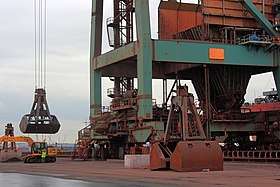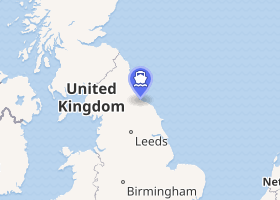Redcar Bulk Terminal
Redcar Bulk Terminal (RBT), also known as Redcar Ore Terminal, is a privately run dock at the mouth of the Tees Estuary in North Yorkshire, England. The port is used for the transhipment of coal and coke (both inward and outward flows) and for many years was the import dock for iron ore destined for Redcar Steelworks under British Steel Corporation, British Steel plc, Corus, Tata Steel Europe and SSI UK.
| Redcar Bulk Terminal | |
|---|---|
 Bulk Ore Terminal, Redcar | |

| |
| Location | |
| Country | England |
| Location | Redcar |
| Coordinates | 54°37′28.2″N 1°09′09.7″W |
| UN/LOCODE | GB RER |
| Details | |
| Opened | 1973 (rebuilt) |
| Owned by | British Steel 50% UK Government 50% |
| Land area | 320 acres (130 ha) |
| Draft depth | 17 metres (56 ft) |
| Employees | 89 (2019)[1] |
| Rail mounted gantry cranes | 2 |
| Statistics | |
| Annual cargo tonnage | 3,000,000 tonnes (3,300,000 tons) |
| Passenger traffic | None |
| Website Official website | |
The port is not part of the named Teesport estate run by PD Ports and is half owned by the new British Steel company and half owned by the UK Government. It is only one of four UK ports that are capable of handling Capesize vessels.
History
Located in the borough of Redcar and Cleveland in the historic county of North Yorkshire, the bulk terminal is on the south bank of the River Tees.[2] It is the deepest part of the Teesport area and the deepest port (56 feet (17 m)) in eastern England.[3] The port is capable of handling Panamax and Capesize vessels, with Redcar being only one of four that can take the Capesize vessels in the United Kingdom.[4]
The site at Redcar had been used as a dock since the 1850s,[5] and had also been investigated by the Shell oil company as possible site for their operations, but despite an optimistic assessment by a hydraulics engineering company, Shell did not build on the site with their operations being located further upstream.[6] The site was chosen by Sir W Halcrow and the new terminal was announced in 1969 when it was also considered as a point of import for iron ore for the Scunthorpe Steelworks, but British Steel Corporation (BSC) opened a second iron ore dock at Immingham to supply the Lincolnshire side of its operations.[7] Whilst primarily an import terminal for Teesside, the terminal began running trains to Consett Steelworks from 1974 for BSC instead of those trains originating on Tyneside.[8]
Between 1969 and 1972, an area covering over 645,835 square feet (60,000 m2) was excavated with depths up to 148 feet (45 m).[9][10] The company created the bulk import terminal to supply the adjacent Redcar Steelworks which had been opened in 1917 by Dorman Long and which became part of British Steel Corporation in 1967.[11] £15 million was spent locating the port on the edge of the 1,500-acre (610 ha) Redcar steel estate[12] which could accommodate vessels of between 150,000 tonnes (170,000 tons) and 200,000 tonnes (220,000 tons) whereas before that, the maximum deadweight (DWT) that could be offloaded at the site was 30,000 tonnes (33,000 tons).[13] An enlarged Redcar port with a 1,048-foot (319 m) quay[6] was opened by the British Steel Corporation (BSC) in 1973 after it had developed the dock area and had the River Tees deepened.[14]
The first vessel to dock there was the "Owari Maru" on the 6 September 1973, a 106,000-tonne (117,000-ton) ship carrying iron ore for the Redcar steelworks.[15]
BSC was privatised into British Steel in 1988 and when British Steel merged with Koninklijke Hoogovens in 1999, the new venture, named Corus, used the facility for the importation of iron ore and coal for the Redcar steelworks.[16] Both Tata, and latterly SSSI (the subsequent owners of the steelworks) used the dock to import raw materials. An average of 8,000,000 tonnes (8,800,000 tons) of iron ore per annum was imported through the dock in 2000–2009 period.[17] In 2009, the steelworks was closed, but Tata retained control of the dock. When the steelworks site was handed over to SSI in 2011, Tata retained a joint stake in the dock to allow them the flexibility to still use it to import coal and iron ore if necessary.[18]
Tata Steel's 50% stake in the venture was later sold to British Steel PLC in 2017; the other 50% per cent is owned by the Official Receiver acting on behalf of the UK Government as it held the assets of SSI UK when it closed down,[19] although the berth itself is actually owned by PD Ports.[20]
The port lost a huge tonnage of its business when the SSI steel plant adjacent was mothballed in 2015.[21] Since then it has handled between 2,000,000 tonnes (2,200,000 tons) and 3,000,000 tonnes (3,300,000 tons) of trade per year, though the complex has the ability to handle 12,000,000 tonnes (13,000,000 tons).[4] The terminal has the ability of unload from a train and load onto another train simultaneously. It also has over 8 miles (13 km) of sidings with over 70% of its business wither arriving or leaving by rail.[1]
In 2019, RBT covered an area of 320 acres (130 ha) and has a connection to the railway lines on south Teesside.[1] In the past, the terminal has despatched trainloads of coal for power stations via many freight operating companies.[22] Imported coal has been moved to power stations (Fiddlers Ferry in 2016 for example) and coal has been forwarded to Redcar from opencast sites in Scotland for export. Due to a downturn in ESI coal imports, trainloads of coal have dropped from 50 per week in 2013 to 15 per week in 2019.[23] The terminal has also been used to import Ground Granulated Blast Furnace Slag (GGBS) to Scunthorpe and also as a forwarding point for unused iron ore from when the adjacent steelworks was closed, both in 2009 and in 2015.[24]
Key products
The letter after the product indicates whether it is imported (I) or exported (E).[25]
- Coal (E future) (I)[26]
- Coke (E) (I)
- GGBS (I)[27]
- Iron ore (1972-2015) (I)
- Petroleum coke (Petcoke) (I)
- Polyhalite (future) (E)
- Scrap metal (E)[28]
Redcar is the preferred option for the export of metallurgical coal (for coking) from the Woodhouse Colliery site in West Cumbria. Up to six trains daily would run between Whitehaven and Redcar delivering the coal.[29][30]
In July 2018, Sirius Minerals, the operators of Woodsmith Mine, signed an agreement to export up to 10,000,000 tonnes (11,000,000 tons) of polyhalite per year from Redcar. The mineral would arrive at the Bran Sands site via a 23-mile (37 km) underground conveyor belt from the Woodsmith Mine site. RBT would then store and export the mineral via its quayside.[31]
References
- Pickering 2019, p. 52.
- "Redcar bulk terminal deal | British Steel". britishsteel.co.uk. 9 July 2018. Retrieved 16 July 2018.
- Isaac, Anna (23 September 2017). "Freeing Teesport: could it help Britannia rule the waves?". The Telegraph. Retrieved 11 July 2018.
- Yeomans, Jon (9 July 2018). "Sirius Minerals to use former Redcar steel port in boost for Tees Valley". The Telegraph. Retrieved 11 July 2018.
- "History". www.teesbaypilots.co.uk. Retrieved 16 July 2018.
- Guillou, M. Le (1978). A history of the River Tees, 1000-1975. Middlesbrough: Cleveland County Libraries. p. 161. ISBN 0-904784-06-1.
- Fisher, Nigel (7 February 2011). "Major steel investment came at a huge price". Grimsby Telegraph. ProQuest 849558674.
- Ringer, Brian (July 2015). "The Climb to Consett". Backtrack. Vol. 7 no. 291. Easingwold: Pendragon. p. 445. ISSN 0955-5382.
- Puller, Malcolm (2003). Deep excavations : a practical manual (2 ed.). London: Telford. p. 122. ISBN 0-7277-3150-5.
- "Deepening of River Tees for British Steel Corporation Ore Terminal site at Redcar Wharf". discovery.nationalarchives.gov.uk. Retrieved 10 July 2018.
- Leatherdale, Duncan (3 October 2015). "The firm that bridged the world". BBC News. Retrieved 11 July 2018.
- "40 Years Ago". Middlesbrough Evening Gazette. 8 August 2009. ProQuest 351357907.
- Irwin-Childs, F; Knowles, A S; Fuchsberger, M (May 1975). "Redcar Ore Terminal". Proceedings of the Institution of Civil Engineers. Institution of Civil Engineers. 58 (2): 125–161. doi:10.1680/iicep.1975.3800. ISSN 1753-7789.
- "The region with an iron backbone". Evening Gazette. 7 December 2010. ProQuest 816324114.
- Guillou, M. Le (1978). A history of the River Tees, 1000-1975. Middlesbrough: Cleveland County Libraries. p. 162. ISBN 0-904784-06-1.
- Shannon, Paul (2008). Rail freight since 1968 : bulk freight. Great Addington, Kettering: Silver Link. p. 79. ISBN 978-1-85794-299-6.
- Bounds, Andrew (27 July 2009). "Fortunes ebb and flow at northern ports". Financial Times. ProQuest 250216539.
- "2011 | Tata Steel in Europe". www.tatasteeleurope.com. 24 February 2011. Retrieved 16 July 2018.
- "All About Shipping". www.allaboutshipping.co.uk. 1 June 2017. Retrieved 13 July 2018.
- "MPs press government on clean-up of Teesside steel plant". Financial Times. 4 February 2016. Retrieved 14 July 2018.
- "UK Port Freight Statistics: 2016" (PDF). assets.publishing.service.gov.uk. 1 September 2017. p. 6. Retrieved 14 July 2018.
- Brailsford, Martyn (2016). Railway Track Diagrams 2: Eastern (4 ed.). Frome: Trackmaps. p. 47. ISBN 978-0-9549866-8-1.
- Pickering 2019, p. 55.
- Shannon, Paul (March 2018). "Railfreight 2017 Review". Railways Illustrated. Stamford: Key Publishing. 16 (181): 54 61. ISSN 1479-2230.
- "Redcar Bulk Terminal Limited - Land Sea and Air Magazine". landseaairmagazine.com. 11 November 2016. Retrieved 11 July 2018.
- Rawlinson, Mark (Spring 2010). Freightmaster (57 ed.). Swindon: Freightmaster Publishing. pp. 108–109. OCLC 931138456.
- "Redcar Bulk Terminal secures major contracts with Javelin Commodities and Hanson after British Steel acquires 50% stake". British Steel. 9 October 2017. Retrieved 13 July 2018.
- "News in brief 01/07/16". Resource Magazine. 1 July 2016. Retrieved 14 July 2018.
- "How will materials be transported? - West Cumbria Mining". West Cumbria Mining. Retrieved 13 July 2018.
- Jones, Ben (March 2018). "Coal traffic for Cumbrian coast?". The Railway Magazine. Vol. 164 no. 1, 404. Horncastle: Mortons Media. p. 78. ISSN 0033-8923.
- Snowden, Ros (10 July 2018). "Giant potash mine signs deal for port and loading facilities". The Yorkshire Post. Business. p. 10. ISSN 0963-1496.
Sources
- Pickering, Graeme (27 March 2019). "Cumbria to Teesside...and the world". Rail Magazine. No. 875. Peterborough: Bauer Media. ISSN 0953-4563.CS1 maint: ref=harv (link)